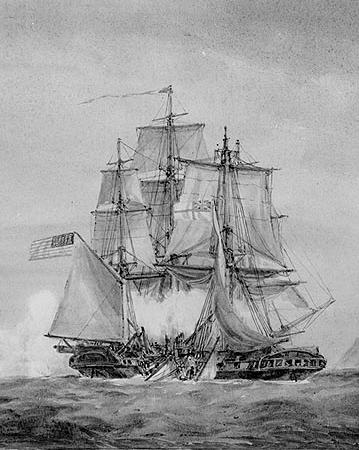Benjamin P. Kissam's Story
I first learned of the story through an entry on page 51 of A Gentlemanly and Honorable Profession by Christopher McKee. Under Benjamin's portrait this is written:

Portrait is in USS Constitution Museum in Massachusetts
Persistence rewarded. New Yorker Benjamin Kissam's determined eye had long been fixed on a surgeon's appointment in the navy. A graduate of the medical program at Columbia College (Ed. note: he would graduate in 1816 from the Columbia College of Surgeons and Physicians, cite), Kissam put one recommendation after another on file at the Navy Office without success until he accidentally encountered Commodore John Rodgers on the first day of April 1812 and was told by the commodore that, if Kissam could join the brig Nautilus more or less immediately as acting surgeon, the post would be his. Even with one foot in the door, it still required sixteen months and a steady barrage of recommendatory letters from the likes of John Rodgers, William M. Crane, and James Lawrence to replace the acting appointment with a commission. At war's end Surgeon Kissam had an opportunity to put his professional training to full use as Hornet's chief medical officer in her encounter with Penguin. His portrait, by an unknown artist, was probably painted not too long after the War of 1812; the landform dimly glimpsed in the background may be Tristan da Cunja, the site of Hornet's 1815 victory.
When war with England broke out in June of 1812 it appears that Benjamin was on the Nautilus as it seems it was rather normal at that time to serve with a commission to come later. The Bulletin of the New York Academy of Medicine notes that he was appointed surgeon for the ship in May of 1812. On 17 July 1812 though, Nautilus gained the dubious distinction of being the first vessel lost on either side. She was captured off northern New Jersey by a squadron built around Shannon (38 guns), Africa (64 guns), and Aeolus (32 guns), and the brig was taken into possession for the use of the King’s service. (cite) The article in the Bulletin also notes that Benjamin was captured in this action though returned. I couldn't find any more details on that specifically.
On July 24 1813 Benjamin finally received his commission. At this point he should be on Hornet though I've had difficulty finding naval registers online. He doesn't appear on a list of officers for Hornet during an action when Hornet sunk the Peacock on 24 February 1813. (cite) For much of 1813 and most of 1814 Hornet was in port at New London, Connecticut, unable to leave in the face of superior British forces offshore. However, she got to sea in mid-November 1814 and sailed to the south Atlantic where she found Penguin in early 1815. (cite)
The following is a description of the action involving Penguin (cite):

Though the United States had ratified the 24 December 1814 Treaty of Ghent on 18 February 1815, thus formally bringing the War of 1812 to an end, this information took a long time to reach ships at sea. Thus, in the late morning of 23 March 1815, when the U.S. Sloop of War Hornet (Master Commandant James Biddle) sighted the British brig-sloop Penguin (of similar size and force) off Tristan d'Acunha island in the south Atlantic, neither vessel was aware that their two nations were now at peace.
The two sloops approached each other on roughly parallel courses, Penguin to windward, and opened fire at about 1:40PM. They exchanged broadsides (Hornet firing to starboard, Penguin to port) for some fifteen minutes when the British commanding officer was mortally wounded while attempting to run down his adversary. Penguin's bowsprit then caught in Hornet's rigging and, as the two separated, broke away, taking with it her foremast. Disabled and very much the worse off from American gunfire, the British warship surrendered shortly after 2PM. She was too badly damaged to save, and her crew was sent to Rio de Janeiro in the U.S. Schooner Tom Bowline, which arrived on the scene in company with U.S. Sloop of War Peacock soon after the battle.
There is an interesting eyewitness account involving Benjamin and surgery from the battle on page 124 of the original source.
Benjamin went on to continue in the Navy until 1823 according to the Bulletin article though I've found him on a naval register for 1825 aboard the corvette Cyane in the Mediterranean (cite). He was given time off to finish his degree in 1816. There is an obituary for him in a Virginia newspaper noting that he died in Portsmouth, New Hampshire in October 1828. (cite)
Unfortunately I'm running out of time and won't be able to post Samuel's rather short story but I'll be back soon. Here are two other references related to Benjamin P. Kissam and his time in the Navy which I haven't checked out yet:
• A History of Medicine in the Early U.S. Navy by Harold D. Langley
• Benjamin P. Kissam, Naval Surgeon in the War of 1812 by Paul Cushman(journal article)

No comments:
Post a Comment